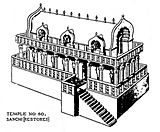Bindusara facts for kids
Quick facts for kids Bindusara |
|
|---|---|
| Amitraghata | |

A silver coin of 1 karshapana of the Maurya empire, period of Bindusara Maurya about 297-273 BC, workshop of Pataliputra. Obv: Symbols with a Sun Rev: Symbol Dimensions: 14 x 11 mm Weight: 3.4 g.
|
|
| 2nd Mauryan emperor | |
| Reign | c. 297 – c. 273 BCE |
| Coronation | c. 297 BCE |
| Predecessor | Chandragupta Maurya (father) |
| Successor | Ashoka (son) |
| Died | c. 273 BCE |
| Issue | Susima, Ashoka, Dhrupad, Vitashoka,and 98 sons ( according to mahawansa) |
| Dynasty | Maurya |
| Father | Chandragupta Maurya |
| Mother | Durdhara (according to Jain tradition) |
Bindusara was the second emperor of the Maurya Empire in ancient India. He ruled from about 297 to 273 BCE. Bindusara was the son of Chandragupta Maurya, who founded the empire. He was also the father of Ashoka the Great, one of India's most famous rulers.
Bindusara helped make the empire stronger and bigger. He took over from his father and passed the empire on to his son. Much of what we know about Bindusara comes from old stories and legends. These were written many years after he lived.
Contents
Who Was Bindusara?
His Family and Birth
Bindusara was the son of Chandragupta Maurya, the first Mauryan emperor. His mother's name was Durdhara, according to some ancient texts.
There's a cool legend about how Bindusara got his name. His father's advisor, Chanakya, would put tiny bits of poison in Chandragupta's food. This was to make him immune to poison attacks. One day, Chandragupta shared his food with his pregnant wife. Chanakya arrived just as she ate the poisoned food. To save the baby, he cut open the queen's belly. He then placed the baby in the belly of a freshly killed goat each day for seven days. When the baby was "born," his body had spots ("bindu") of goat's blood. So, he was named Bindusara. Another version says a drop of poison touched his head, giving him the name.
Bindusara had many sons, possibly as many as 101 from 16 different women! His most famous sons were Susima and Ashoka the Great. Ashoka's mother was named Subhadrangi or Dhamma. Bindusara didn't like Ashoka much at first.
What His Names Mean
Bindusara was also known by other names. The Greeks called him "Amitrochates." This name likely came from the Sanskrit title "Amitraghāta." This means "slayer of enemies" or "devourer of enemies." He was also called Devanampriya, which means "The Beloved of the Gods." This was a title also used by his son Ashoka.
Bindusara's Reign
Bindusara became emperor around 297 BCE. He continued the work of his father, Chandragupta.
Expanding the Empire
Some ancient texts say that Bindusara conquered many new lands. A Tibetan writer named Taranatha said Bindusara's advisor, Chanakya, helped him take control of all the land between the western and eastern seas of India. This might mean he conquered the southern part of India called the Deccan Plateau.
However, some historians disagree. They think the Mauryan Empire already reached these areas during Chandragupta's time. Also, Ashoka's inscriptions in southern India don't mention his father conquering those lands. So, Bindusara might have focused more on keeping the empire strong. He likely organized and managed the vast lands he inherited.

Dealing with Revolts
Bindusara faced some challenges during his rule. There was a revolt in a city called Takshashila. Bindusara sent his son Ashoka to deal with it. The people of Takshashila told Ashoka they were only against Bindusara's unfair ministers. They had no problem with the emperor or the prince. Ashoka entered the city peacefully.
Later, there was another revolt in Takshashila. This time, Bindusara sent his other son, Sushima, but he couldn't stop the rebellion.
His Ministers
Bindusara had important advisors, just like his father. Chanakya, who was Chandragupta's prime minister, might have continued to serve Bindusara. There's a story that Chanakya retired and later died because of a misunderstanding with Bindusara and another minister named Subandhu.
Bindusara also had 500 royal advisors. Two of them, Khallataka and Radhagupta, later helped Ashoka become emperor.
Friends with Other Countries
Bindusara had good relationships with Greek rulers. Deimachus was an ambassador from the Greek Seleucid Empire who visited Bindusara's court. Bindusara even asked the Greek king Antiochus I to send him sweet wine, dried figs, and a philosopher. Antiochus sent the wine and figs but said Greek law didn't allow him to sell a philosopher. This shows Bindusara was interested in Greek ideas and knowledge.
An Egyptian king, Ptolemy II Philadelphus, also sent an envoy named Dionysius to India during Bindusara's time.
Bindusara's Beliefs
Some ancient texts suggest that Bindusara followed Brahmanism, an ancient Indian religion. There is no clear proof that he followed Jainism, even though his father Chandragupta did.
Interestingly, some Buddhist stories mention an Ajivika astrologer at Bindusara's court. This astrologer predicted that Prince Ashoka would become a great ruler. This might mean Bindusara supported the Ajivika religion, which was another ancient Indian belief system.
End of His Reign
Bindusara passed away around 273 BCE. He ruled for about 25 to 28 years. After his death, there was a struggle among his sons to become the next emperor.
All historical sources agree that his son Ashoka became the next ruler. One story says Ashoka rushed to the capital when his father was very ill. He then fought and defeated his brothers to become emperor. Another story says that Bindusara's ministers helped Ashoka take the throne. This was because his older brother Sushima was away dealing with a rebellion.
See also
 In Spanish: Bindusara para niños
In Spanish: Bindusara para niños



